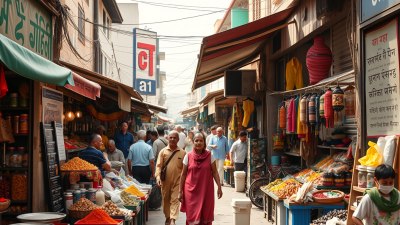You’ve Been to This Place in Someone Else’s Memory
Explore the intricacies of memory and its connection to our experiences in this captivating journey.

Image created with Flux Schnell
Memories are the threads that weave together our identities, and they connect us in ways that often defy explanation. The idea that you’ve been to a place in someone else’s memory suggests an intersection of experiences, emotions, and narratives that can transcend individual lives. Imagine walking through a vibrant street market filled with colors, the smell of various spices, and the sound of laughter and chatter. This memory may belong to someone else, yet as you experience it, you feel an undeniable sense of familiarity and belonging. Welcome to the world where memories are shared, experienced vicariously, and intricately linked.
The concept of sharing memories isn’t merely philosophical; it’s grounded in the science of how we form and recall memories. When we listen to stories or view photographs, our brains engage in a form of experiential empathy, allowing us to visualize and feel what another person has experienced. This phenomenon raises fascinating questions: Can we truly experience a memory that isn’t our own? How do our recollections blend with those of others to create a tapestry of collective experience? In this exploration, we will delve into the psychology of memory and how our senses play a pivotal role in shape our perceptions.
The Anatomy of Memory
To understand how we can feel connected to someone else's memories, we need to look at how memories are formed. The brain encodes experiences through a process that involves various stages: encoding, storage, and retrieval. When you have an experience, sensory information—sights, sounds, smells—gets processed by your brain. This then gets stored in different memory systems, primarily the hippocampus for episodic memories and the amygdala for emotional memories. Retrieval is what allows you to recall these memories later, sometimes triggered by specific stimuli associated with the original experience.
Memory is also not a static entity; it’s incredibly malleable. Recent studies have shown that when we remember an event, we are often rewriting that memory each time we retrieve it. Other people's recounts can influence this process, adding layers of interpretation and emotion. This flexibility in our recalling can make one feel that they have experienced someone else's memory—for instance, hearing a friend's story about their travel to a beautiful city may invoke vivid imagery and emotions, almost as if you have walked their journey alongside them.
Our sensory experiences are crucial in making memories vivid and relatable. Sight, sound, touch, taste, and smell can trigger powerful recollections, enhancing our ability to remember and relate to someone else's experiences. For example, a specific scent, like the smell of roasted coffee beans, can transport you back to moments shared with friends in a cozy café, even if those moments are not your own. This means that certain memories can be evoked not just by direct experience, but by sensory cues that resonate with our cognitive frameworks.
Consider how filmmakers and authors craft narratives that evoke strong imagery and feelings, allowing audiences to traverse time and space. When a character in a movie recalls a summer in a sunlit garden, viewers may find themselves reminiscing about their own similar experiences, blending their memories with that of the character. This blurring of lines can lead to a profound impact on both emotional and psychological levels. The narratives become conduits through which we share and experience memories with others, transcending our individual timelines.
The Power of Storytelling
Storytelling is one of the oldest forms of communication and serves as a bridge for sharing memories across generations. When we recount our experiences, we invite others to step into our shoes, to feel our emotions, and to reflect on their own memories. This shared storytelling can strengthen bonds and create a shared understanding among individuals. It opens the door to empathy, enabling us to connect not just with our memories but also with those of others.
For example, family gatherings often invoke storytelling sessions where relatives share tales of their past. A shared recollection of a cherished family vacation can simultaneously evoke nostalgia for the teller while resonating with listeners in their own unique ways. The beauty of storytelling lies in its capacity to create community around shared experiences, highlighting our interconnectedness.
Collective Memory and Cultural Identity
Collective memory refers to how groups of people remember their shared past, shaping cultural identities and societal values. This phenomenon illustrates how memories are not solely individual; they can also be collective, influencing communities and cultures. For instance, public events, such as national holidays or memorials, often reflect collective memories that forge a common identity.
Consider how cultural practices, folklore, and rituals are passed down through generations. They often involve the retelling of memories that have shaped the community's ideals and beliefs. This shared recollection fosters unity and allows for a sense of belonging, as each individual contributes their interpretation of these memories, enriching the collective narrative.
Contemplating Reality
While sharing memories can foster connection and understanding, it's essential to acknowledge the complexities of memory itself. Our memories can be influenced by time, context, feelings, and even social interactions. The reliability of memory is frequently challenged; memories can be reconstructed and distorted, leading to discrepancies between a person's recollection and the actual events. This begs the question: if two individuals remember the same event differently, can we still say they are 'shared' memories?
This subjectivity highlights the importance of being mindful when recounting memories, as they are woven from both personal and shared threads. It’s not just about reliving experiences but understanding the layers involved—the nuances of perception, interpretation, and the emotional weight carried by each memory. In this sense, experiencing someone else's memory can lead one to question the very nature of personal reality.
The Digital Age of Memory Sharing
The advent of technology has transformed how we share and engage with memories. Social media platforms enable us to capture moments in real-time and often result in a digital footprint of our lives. Photos, videos, and posts serve as modern-day vessels for memory sharing, allowing friends and family to glimpse experiences that may otherwise remain unshared. A simple picture of a beautiful sunset on Instagram can evoke appreciation and envy, bridging distances and allowing for shared moments across the globe.
However, this digital memory-sharing brings forth its own challenges. Curated content on social media can create an illusion of idealized experiences, often distorting the reality of shared memories. The pressure to project a perfect life can lead to feelings of inadequacy and isolation, as individuals compare their own experiences with the seemingly perfect lives presented online. Balancing the authenticity of real shared experiences with the curated nature of digital memory is crucial for maintaining genuine connections.
Healing Through Shared Memories
As much as shared memories can connect us, they also play an essential role in the healing process. Grieving individuals often find solace in sharing memories of loved ones who have passed, creating a space to reflect and honor their legacy. These memories become the means to celebrate the relationship and maintain a connection that lives on through storytelling.
Support groups emphasize the power of shared experiences in healing. Individuals recounting their struggles, facing similar life challenges create an environment of understanding and compassion. When someone tells their story of loss or trauma, it resonates with others, validating their feelings and experiences. The act of recounting memories fosters a sense of belonging and community, washing away the isolation that often accompanies challenging times.
The Interwoven Tapestry of Memory
In the intricate dance of memory, each individual's experiences are interwoven with those of others, creating a tapestry that reflects the human condition. Whether through the lens of storytelling, shared sensory experiences, or the exploration of collective memories, our journeys become a shared narrative that transcends individual lives. The beauty lies in the recognition that while we may not have walked in someone else’s shoes, their memories can resonate within us, offering a glimpse into their world and a deeper understanding of our own.
As we navigate this complex landscape of shared memories, we must foster empathy, attentiveness, and authenticity in recounting our stories. By honoring the interconnectedness of our experiences, we enrich not only our lives but also the lives of those around us, ultimately crafting a shared history that resonates through time.











